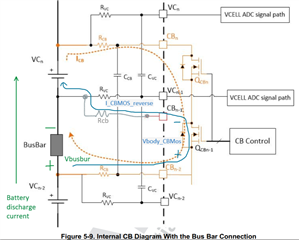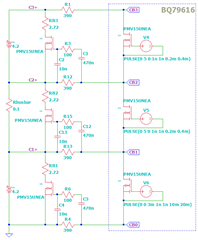Hi,
as we would to use a single board configuration (one assembly variant) for different batteries, we are thinking to do not respect the following reccomendation, reported on SLVAE87 – FEBRUARY 2019 document.
" 5.3 Bus Bar on Individual VC Channel:
With the bus bar connected to a VC channel individually, the upper CB pin on that channel shall be left floating to avoid forward biasing the internal CBFET (see Figure 5-5 connection). "
The following figure represent the desired situations (pls, neglet the orange current on the following considerations):

In other words we would to mount Rcb resistance, connecting the upper CB pin to the busbar, also in the channel used on busbar measurement (in gray).
Consider the situation in which the battery module is in discharging: the green current "Battery discharge current" flows from negative to positive battery terminal thus a voltage drop shown as "Vbusbar" is present across the busbar. This voltage drop makes that a current (in blue, named I_CBMOS_REVERSE) will flow across the internal CB mosfet. In particular through its body diode.
- Is this the "the forward biasing of the internal CBfet" that you are referring for in the SLVAE87 document and that must be avoided?
- This I_CBMOS_REVERSE is limited by the Rcb resistances (2 x 100ohm in our case). Based on oure estimation of the voltage drop on the busbar (Vbusbar), just a little current (< 50mA) will flow on the body diode.
- What is the maximum current that the body diode of the CB mosfet can support?
- There will be some issue if some limited current flows on it?
- It seems the same situation occurs also when using the external balancing mosfet, on the external mosfet's body diode. As there is only the balancing resistor that limits the current, this current will be higher. Howerer, from our simulation, it seems that this will be not destroy the ext. mosfet. If we can keep safe the ext CB mosfet, are there any counterindication in leaving the upper CB pin connected to the busbar?
Thank you,
Best regards


